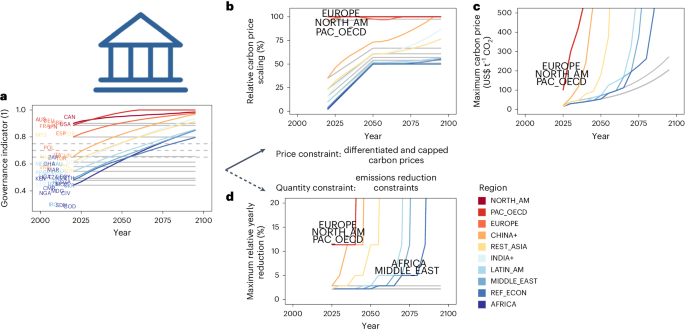Feasibility of peak temperature targets in light of institutional constraints
IF 29.6
1区 地球科学
Q1 ENVIRONMENTAL SCIENCES
引用次数: 0
Abstract
Despite faster-than-expected progress in clean energy technology deployment, global annual CO2 emissions have increased from 2020 to 2023. The feasibility of limiting warming to 1.5 °C is therefore questioned. Here we present a model intercomparison study that accounts for emissions trends until 2023 and compares cost-effective scenarios to alternative scenarios with institutional, geophysical and technological feasibility constraints and enablers informed by previous literature. Our results show that the most ambitious mitigation trajectories with updated climate information still manage to limit peak warming to below 1.6 °C (‘low overshoot’) with around 50% likelihood. However, feasibility constraints, especially in the institutional dimension, decrease this maximum likelihood considerably to 5–45%. Accelerated energy demand transformation can reduce costs for staying below 2 °C but have only a limited impact on further increasing the likelihood of limiting warming to 1.6 °C. Our study helps to establish a new benchmark of mitigation scenarios that goes beyond the dominant cost-effective scenario design. The Paris Agreement requires reaching net-zero carbon emissions, but a debate exists on how fast this can be achieved. This study establishes scenarios with different feasibility constraints and finds that the institutional dimension plays a key role for determining the feasible peak temperature.


根据体制限制实现最高气温目标的可行性
尽管清洁能源技术部署的进展快于预期,但从 2020 年到 2023 年,全球二氧化碳年排放量仍在增加。因此,将升温限制在 1.5 ° C 的可行性受到质疑。在此,我们介绍了一项模型相互比较研究,该研究考虑了 2023 年之前的排放趋势,并将具有成本效益的情景与具有制度、地球物理和技术可行性限制的替代情景进行了比较。我们的结果表明,根据最新的气候信息,最雄心勃勃的减缓轨迹仍能将峰值升温限制在 1.6 ℃ 以下("低超调"),可能性约为 50%。然而,可行性制约因素,尤其是制度方面的制约因素,将这一最大可能性大大降低至 5-45%。加快能源需求转型可以降低将升温控制在 2 °C 以下的成本,但对进一步提高将升温控制在 1.6 °C 的可能性影响有限。我们的研究有助于建立一个新的减缓情景基准,它超越了主流的成本效益情景设计。
本文章由计算机程序翻译,如有差异,请以英文原文为准。
求助全文
约1分钟内获得全文
求助全文
来源期刊

Nature Climate Change
ENVIRONMENTAL SCIENCES-METEOROLOGY & ATMOSPHERIC SCIENCES
CiteScore
40.30
自引率
1.60%
发文量
267
审稿时长
4-8 weeks
期刊介绍:
Nature Climate Change is dedicated to addressing the scientific challenge of understanding Earth's changing climate and its societal implications. As a monthly journal, it publishes significant and cutting-edge research on the nature, causes, and impacts of global climate change, as well as its implications for the economy, policy, and the world at large.
The journal publishes original research spanning the natural and social sciences, synthesizing interdisciplinary research to provide a comprehensive understanding of climate change. It upholds the high standards set by all Nature-branded journals, ensuring top-tier original research through a fair and rigorous review process, broad readership access, high standards of copy editing and production, rapid publication, and independence from academic societies and other vested interests.
Nature Climate Change serves as a platform for discussion among experts, publishing opinion, analysis, and review articles. It also features Research Highlights to highlight important developments in the field and original reporting from renowned science journalists in the form of feature articles.
Topics covered in the journal include adaptation, atmospheric science, ecology, economics, energy, impacts and vulnerability, mitigation, oceanography, policy, sociology, and sustainability, among others.
 求助内容:
求助内容: 应助结果提醒方式:
应助结果提醒方式:


